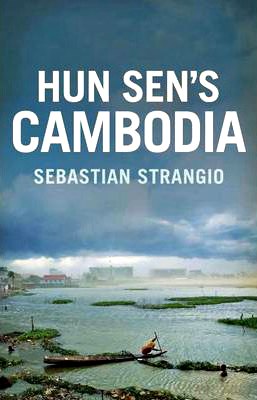By Tony Kevin | 13 November 2014

I had long since completed my posting to Cambodia as Australian Ambassador 1994-97, the decisive years of the post-UNTAC struggle for power between Cambodian People’s Party (CPP) leader Hun Sen, royalist party leader Prince Ranariddh, dissident democratic leader Sam Rainsy, and King Sihanouk.
Today just two of those players are left standing: Cambodian People’s Party (CPP) leader Hun Sen and Sam Rainsy, leader of a newly invigorated and resurgent opposition coalition, the Cambodian National Rescue Party (CNRP). Ranariddh retired from politics in 2008, and his Funcinpec party is no more: its most impressive leaders like Mu Sochua moved to Sam Rainsy’s party and now its successor CNRP. The much-loved and hugely talented King passed on in 2012. His successor King Sihamoni is strictly apolitical.
Rainsy and his deputy CNRP leader Kem Sokha (an experienced democratic politician who founded the Human Rights Party in 2007) skilfully pursue an agenda of social reform and Cambodian nationalism, and have built a young constituency of human rights idealists and have-nots with much to gain and little to lose in challenging the CPP ascendancy.
Hun Sen’s CPP – which had grown ever stronger in the elections of 1998, 2003 and 2008 as it cemented its control of local government in the regions – had its first shock reverse in 2013. Its share of seats in the National Assembly was slashed from 90 to 68. The CNRP won the remaining 55 seats and is now within clear striking distance of taking power at the ballot box in 2018. A shocked CPP is finding its old levers of power and patronage working less and less well in this rapidly changing and urbanising society and economy.
In July 1997, when the mounting hostility between Hun Sen and Ranariddh erupted in open war, a small group of Western and ASEAN ambassadors had agreed (at some risk to our careers) to advise our governments not to take sides. We knew that Hun Sen had the power and leadership skills to win on the ground. For our governments to prop up Ranariddh (now negotiating secretly with armed remnants of the Khmer Rouge) would have risked reigniting the 1978-91 civil war and destroying everything that the UN peace settlement had achieved in 1991-93.
Our advice was heeded in capitals. Over the next 16 years, Hun Sen skilfully consolidated political and economic power: destroying, intimidating or buying off adversaries, mostly peacefully, to a point where Cambodia seemed well on the road to becoming a one-party dictatorship under Hun Sen. Until 2013.
Now, it seems, the growth of politically more savvy urban middle and working class voters has created an electoral basis for a political opposition led by Sam Rainsy and Kem Sokha, to take power peacefully in 2018.
This in itself, if it happens, will raise a host of new questions. How would Rainsy manage relations with Vietnam, having built his career in large part on rhetoric to demonise Vietnam? And how would he take effective control at home? Cambodian politics is built on hierarchical relationships of money and protection. Cambodian politicians remember and reward their friends and punish their enemies. Hun Sen has built powerful entrenched hierarchies around himself, in the army, police and bureaucracy. How would Rainsy deal with them and they with him? There is no strong tradition of separation of powers: party and state are intermeshed around Hun Sen.
A democratic change of government in 2018, if it should come, could be as disruptive as Thaksin’s accession to power was in Thailand in 2001. It is an open question whether Cambodia could remain as peaceful as it is now.
--
So is today’s Cambodia a success story, an utter disaster, or something in between? Former Phnom Penh Post journalist Sebastian Strangio’s impressive new book Hun Sen’s Cambodia (Yale University Press, 2014) is the product of meticulous first-hand in-country research, using a wealth of published sources and interviews, since he first went to work in Cambodia in 2008.
He sets out the balance sheet of what has been gained and lost in the 17 years of peace under Hun Sen since 1997.
Have these years seen a ‘miracle on the Mekong’ – or a mirage of democracy and progress? Strangio concludes on the latter side. He compellingly assembles evidence, some of it desperately sad to read, in support of this judgement. The terrible state of Cambodian public health, with the heartbreakingly high, medically unnecessary, mother-and-baby mortality for women who cannot afford private medicine or lack access to city charitable hospitals. The corrupted state of education, where desperately poor teachers are forced to take bribes to pass mediocre students into scarce higher education places at the expense of better qualified students. The abuse of human rights in the hill country and forestlands especially, as powerful syndicates move in clear-felling forests, depriving traditional tribes of their homes and livelihoods; the forced removal of homeless urban squatters to make way for obscenely rich gated communities; the suppression of worker rights to more decent wages and conditions; the heavily managed and constrained trials of very few Khmer Rouge leaders. It’s a damning indictment of misgovernance that Strangio offers in chapter after chapter of incisive writing.
Yet, as Strangio acknowledges, Phnom Penh is a lively, bustling, often happy city of energetic and industrious people. The urban economic growth statistics are amazing. From 1998 to 2007 GDP grew by nearly 10 per cent per annum. The World Bank reported that in 2004 one in two Cambodians lived in poverty: by 2011 the figure had dropped to one in five. In two decades, per capita income almost quadrupled from $240 in 1993 to a projected $1000 in 2013.
The press, radio and TV are nowadays largely compliant but there is a thriving internet culture, so far free. The young, who demographically dominate, have little interest in the crimes of the past. Hun Sen and his trusted advisers are ageing. Strangio suggests they may be losing their sure touch on this rapidly changing country. Hun Sen’s power will endure longest in the traditional rice growing rural areas. But nowhere in Cambodia is more than a day’s bus ride from Phnom Penh, and through strong family links, new ideas are flowing freely from the capital city to the regions. The CPP has reason to fear the 2018 elections. It must now democratise or perish.
Cambodian foreign policy is not just about fencing with the US and the UN: it is, very centrally, about nearby Thailand, Vietnam and China. In true Sihanouk tradition, Hun Sen has brilliantly balanced the strategically weak Cambodian state among these three powerful neighbours. History will give him credit for this, and I wonder if his successor leaders will show the same deft hand.
So how will history judge Hun Sen’s expected 20 years in power since 1998? I would venture: as an authoritarian but effective national developmental leader, in the ASEAN tradition of Lee Kuan Yew Soeharto and Mahathir. Certainly, his state now operates with a high degree of cronyism and corruption, and a sad dependency on the international community for essential health, education and welfare obligations. But it is only rarely deliberately cruel to its citizens.
And was there ever any viable alternative in 1997? Historians and political observers will go on debating this question, and Strangio’s fine book will be an essential resource in this debate.
 Tony Kevin is a former diplomat. Sebastian Strangio's Hun Sen's Cambodia is available now from online vendors.
Tony Kevin is a former diplomat. Sebastian Strangio's Hun Sen's Cambodia is available now from online vendors.
Tony Kevin